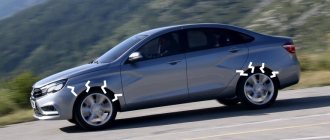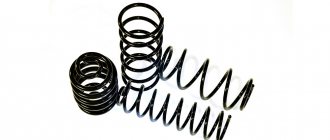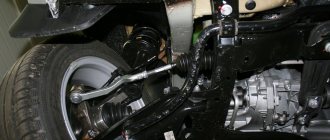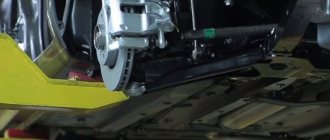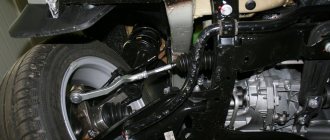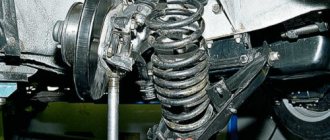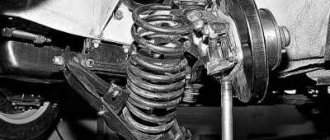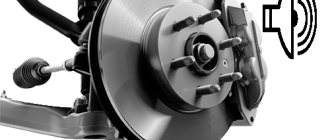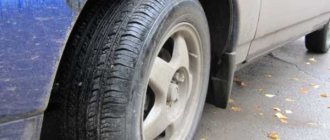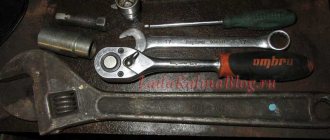Stabilizer struts are one of the weak points of the Lada Vesta. They can fail after just 10 thousand kilometers.
From the factory, Lada Vesta is equipped with racks with plastic hinge bushings. Most often it is the plastic bushings that break. Because of this, the strut begins to play and an unpleasant noise appears while driving.
The most common shortcomings of the Lada Vesta car suspension
Drivers' complaints are caused by extraneous noises, squeaks and crunching sounds from the car's chassis. Most often they occur in the front part of the car, but many also complain about knocking from the rear suspension elements. The most common causes of these sounds are:
- Noise from front stabilizer struts.
Owners of the first Vesta cars began to notice extraneous sounds from the front suspension after several thousand kilometers. The reason for this turned out to be poor-quality stabilizer links. After considering consumer complaints, the manufacturer ordered that these parts be replaced free of charge in case of complaints.
- Rear shock absorbers knocking.
The rear struts knock when driving on rough roads. This is due to the fact that there is no insulating gasket between the shock absorber and the upper support, and metal hits metal when hitting an obstacle. The official service does not undertake to eliminate this deficiency, since it does not affect the driving performance of the car.
Defects of Lada
Lada Vesta has recently rolled off the assembly line and not all warranty workshops have experience in solving problems on how to eliminate knocking noises that occur in the suspension. The manufacturer constantly maintains contact with the service station and makes changes to the design. Let's consider possible malfunctions and methods for eliminating them in the front suspension of the Lada.
Car enthusiasts may be disappointed by a new car almost immediately. An unpleasant creaking and knocking sound appears when passing speed bumps. Upon analysis, it turned out that the problem was in the stabilizer bar bushings.
It is not recommended to lubricate them with grease; they will stop squeaking, but for a very short period of time, so they only need to be changed. They can be replaced with polyurethane ones from Niva Chevrolet. The bushing has catalog number 17012680. After replacement, the squeaking sound disappears.
You should know that these are not all problems; a characteristic knocking sound may occur from the front right.
This is typical when there is increased play in the right ball joint. Replacement is carried out together with the suspension arms assemblies. AvtoVAZ supplies them complete with a ball joint.
Front suspension of the Lada Vesta The main defects that occur in the front part of the Vesta car, which may cause the car to creak or rattle:
- Grinding noise in the anti-roll bar;
- The right ball joint is faulty, it starts knocking;
- The stabilizer links begin to rattle.
It is recommended that all these defects be repaired at AvtoVAZ dealerships.
When driving on an uneven road, you hear a dull knock on small bumps or a sound reminiscent of rubber friction. This problem can be eliminated by lubricating the Vesta muffler mounting with grease. Vesta's front suspension creaking may be due to worn struts.
To eliminate the defect, you just need to replace them with new ones, the problems with the suspension will be solved.
How to identify the cause of the noise yourself?
If the machine is under warranty, if you suspect any malfunction, you must contact your nearest service center. If the warranty has expired or this is not possible, you can try to determine the cause of the unpleasant noise yourself.
To do this, you need to hang the car wheels and move them in different directions. When conducting diagnostics, the following conclusions can be drawn:
- If there is play when the brake pedal is not pressed, then the wheel bearing needs to be replaced;
- If there is something wrong with the suspension, the play will not go away when you press the brake pedal;
- A ball joint defect can be suspected if the play occurs in the vertical plane. This sensation can also occur if the stand is poorly secured;
- Wobbling in the horizontal plane most often indicates a faulty tie rod end.
Having identified the causes of a creaking or rattling noise, it is necessary to eliminate it as soon as possible by replacing damaged parts. It is better to do this at a service station, where specialists will carry out reliable diagnostics and carry out repair work.
Front suspension. What might be a concern?
- Wheel bearings.
Wheel bearing noise can be detected by ear even by a less experienced driver. It howls and rustles when moving and, gradually increasing, begins to drown out all other noises in the cabin. To make sure that it is the bearing that is making noise, you need to turn the steering wheel a little when driving at speeds above 60 km/h. If the rumble appears in one steering position and stops in another, it means the bearing has definitely failed. You can also check this by lifting the car wheel and spinning it. If you hear a characteristic rustling sound, it means the bearing needs to be replaced.
- Stabilizer's pole.
Stabilizer links are the most vulnerable part of the suspension. Due to the poor quality of roads, they often fail and begin to produce a slight but constant noise from under the bottom of the car. You can determine if the struts are broken by resting the lever on the subframe and shaking the stabilizer. If during these actions a knock is heard and play is felt, it means that the stabilizer links are out of order.
These parts are usually replaced in pairs, and you can do it yourself. To do this, you need to hang the front wheels of the car, and using a 16 wrench, unscrew the hinge nuts, while holding them with a 5 hex wrench on the back side so that the hinges do not turn.
- Spherical bearing
The sound of a broken ball joint can be difficult to distinguish from other suspension noises. You can check the play of this unit by moving the suspended wheel in a horizontal plane. If the fault cannot be determined, you can insert a pry bar between the subframe and the lever and press on the resulting stop. This is the easiest way to identify a loose ball pore.
At the service center, the ball joint is replaced along with the lever and silent blocks. But these parts also exist for sale as a separate unit.
Replacing a ball is not an easy operation, so you can tackle it yourself only if you have the necessary tools and metalworking skills.
- Shock absorber.
Many drivers complain about the knocking of Lada Vesta shock absorbers, but their design itself eliminates this possibility. The telescopic strut consists of two cylinders that dampen vibrations while moving on uneven roads. When they break down, the car begins to “sit down”, the road holding is poor, all the unevenness and bumps become clearly noticeable, and the steering deteriorates. In this case, the outflow of liquid or gas from one cylinder to another is disrupted, and the shock absorber rod begins to make characteristic sounds that resemble knocking.
Visually, a breakdown of the oil shock absorber can be determined by drips on the casing, in the presence of which the part must be replaced immediately. You can also rock the car, focusing on the hood. Under normal conditions, after the impact ceases, the machine should swing once and stop moving. If this does not happen, the racks do not absorb as expected.
- Upper rack support
The upper mount of the front shock absorber contains a support bearing that can knock and howl when driving. You can identify a malfunction of this unit in the following way: swing the car in a vertical plane and put your hand on the support. If a part malfunctions, rattling and humming will be felt.
Another method requires completely dismantling the rack. This check can be done simultaneously with replacing the front shock absorbers. After removing the steering knuckle, you need to rotate the strut together with the spring in a circle. The crunching and grinding sound in the upper part of the assembly that occurs during this indicates that the support is faulty.
Like shock absorbers, it is advisable to change the upper supports at the station, since the process of dismantling and installing them is quite complicated.
Wear of stabilizer bushings
The first sign of “fatigue” of the stabilizer sealing bushings is a dull knock when overcoming a speed bump. Even in Lada Vesta, the manufacturer saves on materials and uses the cheapest ones. As a result, the service life of the bushings is short; creaking of the Lada Vesta suspension appears after several tens of thousands of mileage.
Other signs of bushing wear:
- knocking in the area of the front axle when the car rolls;
- beating in the steering wheel at speeds over 60 km/h;
- play in the steering wheel when maneuvering;
- arbitrary deviation of the machine from a given course. Car enthusiasts say that it “takes away” to the side.
The final conclusion will be given by a mechanic after conducting a comprehensive diagnosis.
Rear suspension knocking and noise
Unpleasant knocks from the rear suspension occur less often than from the front, but sometimes they also bother owners of Vesta cars.
The most common phenomena that can cause noise are:
- Rear beam silent blocks;
- Faulty rear shock absorber mounts or shock absorbers themselves;
- Lack of soundproofing gasket between the shock absorber and the upper support.
The first two problems are eliminated by replacing failed components. The knock of the strut on the support does not affect the driving performance and is not a breakdown, but a factory defect of Vesta. You can eliminate it by placing a purchased or self-made gasket between the parts that are closing and emitting an irritating sound.
Why do you still need to replace?
Let's return to the principle of operation of the car's lateral stability unit. When the outer wheel turns, the force of inertia pulls the outer wheel in the direction opposite to the turn, and the inner one tries to break away from the road. Thus, the suspension of the outer wheel is compressed, which forces the stabilizer to rotate upward. This means that the part of the stabilizer closest to the turn attracts the wheel to the road, which, thanks to the force of inertia, tries to break away from the road. The stabilizer lever rotates inside the bushings. There is no point in explaining further why timely repair of failed elements of the stabilization system with high-quality new ones is necessary.
Owner reviews about the Lada Vesta suspension
| Positive | Negative |
| The rubber blocks in the suspension squeaked in the rain from the very first day of purchase. I didn't pay attention when during the maintenance they asked if any suspension sounds were bothering me. I voiced my problem and they replaced my stabilizer bars for free. | I think the car is not worth the money. I chose between Polo, Solaris and Vesta. I took Vesta because it was cheaper, and the quality, as it seemed to me during the test drive, was the same. But, unfortunately, this is not the case. I was disappointed after the first 10 thousand mileage. The automatic transmission works terribly and the suspension rattles like an old Lada. |
| I have owned a Vesta SV Cross car for about a year now. I took it in a minimal configuration, but I’m happy with everything. The cross-country ability is really good, even on our broken country roads. The suspension doesn't make itself felt at all, I haven't changed anything in all this time, and nothing creaks. | In addition to the creaks of the interior and peeling chrome on the decorative elements, the suspension was terribly disappointing. The defective stabilizers were replaced under warranty. But after a while they began to creak again. The rear shock absorbers also make a lot of noise. And in general, the whole suspension is kind of flimsy, as if you were driving a Chinese car! |
| I drove about 3000 km on my Vesta. I go mainly to the dacha and fishing, so the load is almost always full. The suspension behaves decently, at least I didn’t notice any knocks, and during the technical inspection they said everything was fine. | 3 months after the purchase the front began to rattle. And soon the rear shock absorbers. I went to the service several times - they didn’t care about my problems! In the end they agreed to change the racks, but they were not in stock. I'm waiting for the third week, I'm already tired of visiting them! I don’t recommend buying Vesta at all, it’s better to take Rio and not know grief! |
| Overall I like the car. Beautiful, comfortable, roomy and most importantly - inexpensive. What worries me a little is that the steering wheel doesn't respond well when turning at high speeds. This is probably due to the high ground clearance. There are no comments on the suspension, it works properly, no noise was noticed. | In addition to the fact that the front windows were quickly scratched by poor-quality seals, after six months of use on the Vesta, clear knocking noises from the rear suspension began to be heard. It turns out that eliminating noise is not the responsibility of the warranty service, so I had to finish it myself. I bought special fluoroplastic spacers on the market. Installing them is not difficult, but why waste time, especially since the car is completely new? |
Tips for caring for Lada Vesta suspension
- We adhere to the manufacturer’s recommendations regarding the interval of scheduled technical inspection - every 15,000 km;
- The average service life of the suspension is 60 – 65 thousand km. Mandatory preventive maintenance after 15,000 km;
- Purchase components from official points, representative offices, dealers;
- Order paid car repair services only from those service stations that provide a quality guarantee for the work performed;
- Always check the compatibility of parts according to the catalog numbers specified in the operating instructions;
- After carrying out repair work at the service center, check that the technicians have entered maintenance data into the service book.
Driver, remember that a moderate driving style and original parts increase the service life of Lada Vesta parts by 7 - 10%.
Which stabilizer struts are best to install? Obviously, new ones and with factory catalog numbers. Installing parts from other models is a temporary solution to the problem, not always effective or correct.
Conclusion
- The suspension of the Lada Vesta car is of good quality, but has some shortcomings.
- One of the most common reasons for contacting warranty service is knocking and noise from the front and rear suspension.
- Most often, the front stabilizers fail, as well as the rear shock absorbers, which begin to work noisily over time.
- It is possible to make a diagnosis yourself, but the result will not always be unambiguous. If this is possible, it is better to contact a service station to professionally diagnose and, if necessary, repair the car.
